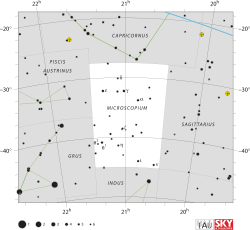Gamma Microscopii

| |
| Observation data Epoch J2000.0 Equinox J2000.0 (ICRS) | |
|---|---|
| Constellation | Microscopium |
| Right ascension | 21h 01m 17.46047s[1] |
| Declination | −32° 15′ 27.9574″[1] |
| Apparent magnitude (V) | 4.680[2] |
| Characteristics | |
| Spectral type | G6 III[3] |
| U−B color index | +0.575[2] |
| B−V color index | +0.882[2] |
| R−I color index | +0.32[4] |
| Astrometry | |
| Radial velocity (Rv) | +17.6[5] km/s |
| Proper motion (μ) | RA: −1.73[1] mas/yr Dec.: +0.41[1] mas/yr |
| Parallax (π) | 14.24 ± 0.26[1] mas |
| Distance | 229 ± 4 ly (70 ± 1 pc) |
| Absolute magnitude (MV) | 0.49[6] |
| Details | |
| Mass | 2.5[7] M☉ |
| Radius | 10[7] R☉ |
| Luminosity | 64[7] L☉ |
| Surface gravity (log g) | 3.34[8] cgs |
| Temperature | 5,050[8] K |
| Metallicity [Fe/H] | –0.22 ± 0.11[9] dex |
| Age | 620[7] Myr |
| Other designations | |
| Database references | |
| SIMBAD | data |
Gamma Microscopii (γ Microscopii, γ Mic) is the brightest star in the faint southern constellation of Microscopium.[7] It has an apparent visual magnitude of 4.68,[2] which is too dim to be viewed from city skies. The distance to this star has been determined using parallax measurements made during the Hipparcos mission, which place it around 229 light-years (70 parsecs) away with a 2% margin of error.[1]
Based upon a stellar classification of G6 III,[3] this is a G-type giant star. It is a core helium fusing star that is classified as a member of the red clump evolutionary branch, although the metallicity of this star—meaning the abundance of elements other than hydrogen and helium—is anomalously low for a member of this group.[9] The effective temperature of the star's outer envelope is 5,050 K,[8] giving it the yellow-hued glow typical of G-type stars.[12]
In the galactic coordinate system, this star has space velocity components of [U, V, W] = [+13.75, +3.47, –10.50] km s−1. The peculiar velocity of this star, relative to its neighbors, is 1.2 km s−1. It has been listed as likely member of the Ursa Major Moving Group of stars that share a similar location and a common trajectory through space.[6] Backwards extrapolation of the motion of γ Microscopii has shown that approximately 3.8 million years ago, it was only around 6 light-years from the Sun.[13] It would then have had an apparent magnitude of −3 and have been brighter than Sirius is now.[7]
Gamma Microscopii has a visual companion, CCDM J21013-3215B at an angular separation of 26 arcseconds along a position angle of 94°, with an apparent visual magnitude of approximately 13.7.[11] Most likely this star is not gravitationally bound to γ Microscopii, but is merely a line of sight companion.[7][14]
Gamma Microscopii was a later designation of 1 Piscis Austrini.[15]
References
- 1 2 3 4 5 6 van Leeuwen, F. (November 2007), "Validation of the new Hipparcos reduction", Astronomy and Astrophysics, 474 (2): 653–664, arXiv:0708.1752
 , Bibcode:2007A&A...474..653V, doi:10.1051/0004-6361:20078357
, Bibcode:2007A&A...474..653V, doi:10.1051/0004-6361:20078357 - 1 2 3 4 Jennens, P. A.; Helfer, H. L. (September 1975), "A new photometric metal abundance and luminosity calibration for field G and K giants.", Monthly Notices of the Royal Astronomical Society, 172: 667–679, Bibcode:1975MNRAS.172..667J, doi:10.1093/mnras/172.3.667
- 1 2 Montes, D.; et al. (November 2001), "Late-type members of young stellar kinematic groups - I. Single stars", Monthly Notices of the Royal Astronomical Society, 328 (1): 45–63, arXiv:astro-ph/0106537
 , Bibcode:2001MNRAS.328...45M, doi:10.1046/j.1365-8711.2001.04781.x
, Bibcode:2001MNRAS.328...45M, doi:10.1046/j.1365-8711.2001.04781.x - ↑ HR 8039, database entry, The Bright Star Catalogue, 5th Revised Ed. (Preliminary Version), D. Hoffleit and W. H. Warren, Jr., CDS ID V/50. Accessed on line November 20, 2008.
- ↑ Wilson, Ralph Elmer (1953). General Catalogue of Stellar Radial Velocities. Washington: Carnegie Institution of Washington. Bibcode:1953GCRV..C......0W.
- 1 2 King, Jeremy R.; et al. (April 2003), "Stellar Kinematic Groups. II. A Reexamination of the Membership, Activity, and Age of the Ursa Major Group", The Astronomical Journal, 125 (4): 1980–2017, Bibcode:2003AJ....125.1980K, doi:10.1086/368241
- 1 2 3 4 5 6 7 Gamma Mic, Stars, Jim Kaler. Accessed on line March 19, 2015.
- 1 2 3 McWilliam, Andrew (December 1990), "High-resolution spectroscopic survey of 671 GK giants. I - Stellar atmosphere parameters and abundances", Astrophysical Journal Supplement Series, 74: 1075–1128, Bibcode:1990ApJS...74.1075M, doi:10.1086/191527
- 1 2 Kubiak, M.; et al. (June 2002), "Metal Abundance of Red Clump Stars in Baade's Window", Acta Astronomica, 52: 159–175, Bibcode:2002AcA....52..159K
- ↑ * gam Mic -- Star in double system, database entry, SIMBAD. Accessed on line November 20, 2008.
- 1 2 Entry 21013-3215, The Washington Double Star Catalog, United States Naval Observatory. Accessed on line November 20, 2008.
- ↑ "The Colour of Stars", Australia Telescope, Outreach and Education, Commonwealth Scientific and Industrial Research Organisation, December 21, 2004, retrieved 2012-01-16
- ↑ García-Sánchez, J.; Weissman, P. R.; Preston, R. A.; Jones, D. L.; Lestrade, J.-F.; Latham, D. W.; Stefanik, R. P.; Paredes, J. M. (2001), "Stellar encounters with the solar system", Astronomy and Astrophysics, 379 (2): 634–659, Bibcode:2001A&A...379..634G, doi:10.1051/0004-6361:20011330
- ↑ Eggleton, P. P.; Tokovinin, A. A. (September 2008). "A catalogue of multiplicity among bright stellar systems". Monthly Notices of the Royal Astronomical Society. 389 (2): 869–879. arXiv:0806.2878
 . Bibcode:2008MNRAS.389..869E. doi:10.1111/j.1365-2966.2008.13596.x.
. Bibcode:2008MNRAS.389..869E. doi:10.1111/j.1365-2966.2008.13596.x. - ↑ Wagman, M. (August 1987). "Flamsteed's Missing Stars". Journal for the History of Astronomy, Vol.18, NO. 3/AUG, P.209, 1987. 18: 220. Bibcode:1987JHA....18..209W.